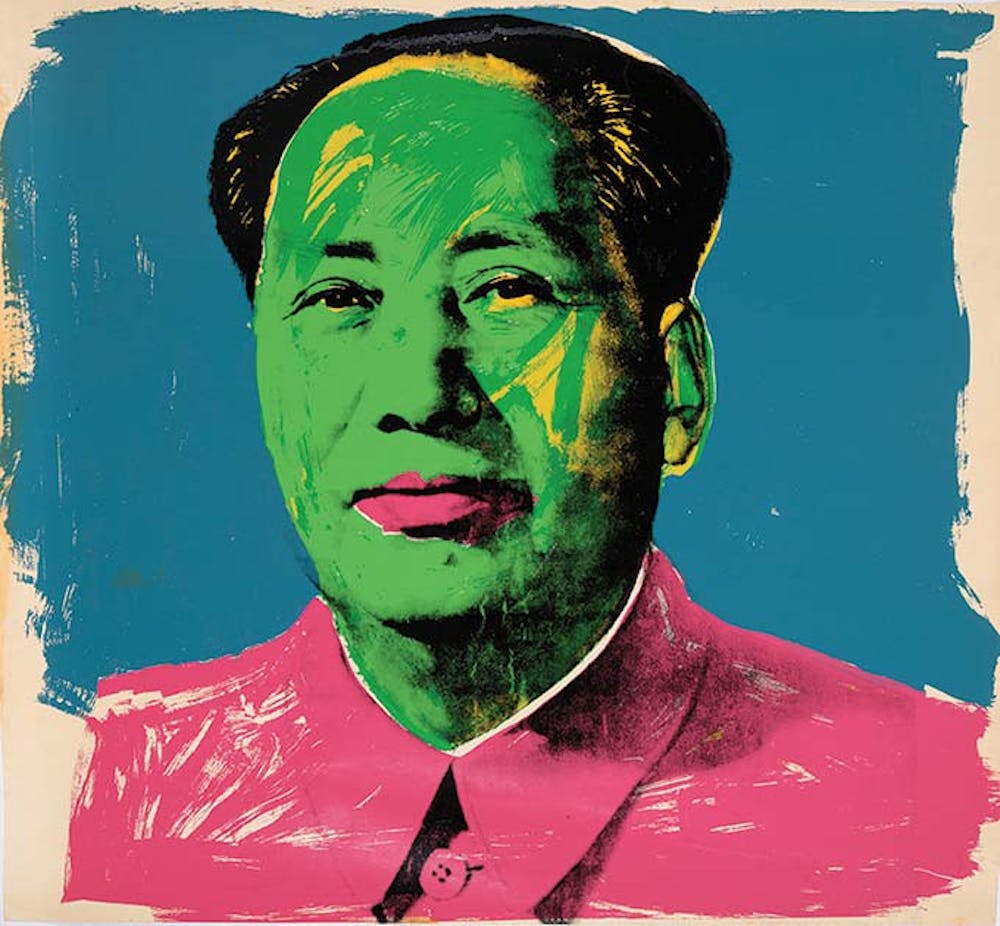Visual art does not produce the kind of recognizable, household names typical of the performing arts - unless, of course, one is referring to Andy Warhol, the late 20th century icon whose often emotionless depictions of popular culture quickly gained him a definitive place among his subjects. This month, the Middlebury College Museum of Art debuted a new collection of ten color Warhol screen prints gifted to the College though a massive, nationwide distribution of the infamous artist’s work in an exhibition called Mao, Sitting Bull, and Others.
Bright colors and bold shapes rejected the more serious art practices of previous generations, and Warhol often used the consumeristic and impersonal process of screen printing to elevate simple objects to a new, accessible art form that resonated strongly with the masses. His studio, self-consciously called “The Factory,” housed prolific production in a variety of mediums, including the creation of over 700 films and the exploration of photography, which the artist often used to take hundreds of still Polaroids of the same object.
As Warhol’s obsession with portraying fame garnered the artist his own unique brand of celebrity, his New York studio became a popular meeting ground for avant-garde artists and curious youth in the 60’s and 70’s.
About 40 Warhol exhibitions are appearing in art institutions and university museums this year as the third and final phase in a massive donation and grant-making effort by the Andy Warhol Foundation for the Visual Arts takes effect. Since 1999, the Foundation has distributed almost 50,000 photographs and prints around the world.
“In the last year, the Warhol Foundation has tried to unload some 14,000 works of art by Warhol that it owns,” Museum of Art Curator Emmie Donadio said. “The Foundation is aiming to use all of its resources to support artists now. Prior to this, they spent a lot of time trying to authenticate Warhol’s art and doing a lot of work for his name, even though he is already one of the best known and selling artists.”
The Foundation, which has a cash endowment of $280 million and assets over $350 million, only gave each receiving institution the stipulation that donated works be exhibited within five years. Additionally, the Foundation will distribute $14 million in cash grants to institutions in the United States in an effort to fulfill Warhol’s desire to support the visual arts.
While Stanford University received the largest donation from the Foundation, including 4,115 sheets of negatives comprising Warhol’s entire collection of black-and-white photography, the College received ten color screen prints, arguably the artist’s most recognizable medium, dating from 1962 to 1986.
In addition to the widely reproduced pink and green rendition of Mao Zedong crafted in 1972, the year of previously staunch anti-communist Nixon’s highly publicized visit to the People’s Republic of China, the collection includes Warhol’s Tomato-Beef Noodle O’s from his second Campbell’s soup collection, showcasing the artist’s ability to entrench both international figures of infamy and seemingly mundane everyday objects into popular culture.
As a curatorial intern on the exhibit, Danny Zhang ’15 discovered firsthand the difficulty of presenting an artist as infamous as Warhol.
“One challenge I faced while putting together the exhibition was synthesizing all the rich information I found about Warhol’s life and the prints we have into concise and easily accessible introductions and wall labels for each work,” Zhang said. “Hopefully, you will find the descriptions in the exhibition straightforward and insightful.”
Though Mao is probably the most famous of the pieces in the exhibition, Ingrid Bergman (The Nun), which portrays the legendary actress in 1945’s The Bell’s of St. Mary, was a Swedish commission and continues to prove Warhol’s international reach.
The exhibit includes an impressive range of works that chart Warhol’s career and interests, from a print based on a photograph depicting his pet pig in a field of colorful Fiesta tableware, to a selection of a Native mother and child from his Cowboys and Indians collection, to a depiction of Queen Ntombi of Swaziland from his collection of the four ruling female monarchs in the world in 1985, Reigning Queens.
“My favorite part of helping to put together the exhibition was learning more about the life and work of an artist whose name everyone recognizes and the subjects that he portrays,” Zhang said. “You can find a lot about Warhol’s life just by doing a quick Google search, but I really enjoyed digging deeper into what his sources of inspiration were, what his personality was like, and what he was trying to tell us through his art.”
Since the prints were gifts to the College, the pieces will remain in the museum’s permanent collection in the storage space used for holdings not on display. Donadio emphasized the unique opportunity for students to see Warhol’s work for free.
“Students are well advised to come to the museum - they’ve heard of Warhol and I’m sure they’ve read about him, but have they ever seen anything firsthand that the artist did? It’s a fantastic opportunity.”
Mao, Sitting Bull, and Others will be on display in the Museum of Art until April 19.
Warhol Prints Find New Home at Midd

Comments



